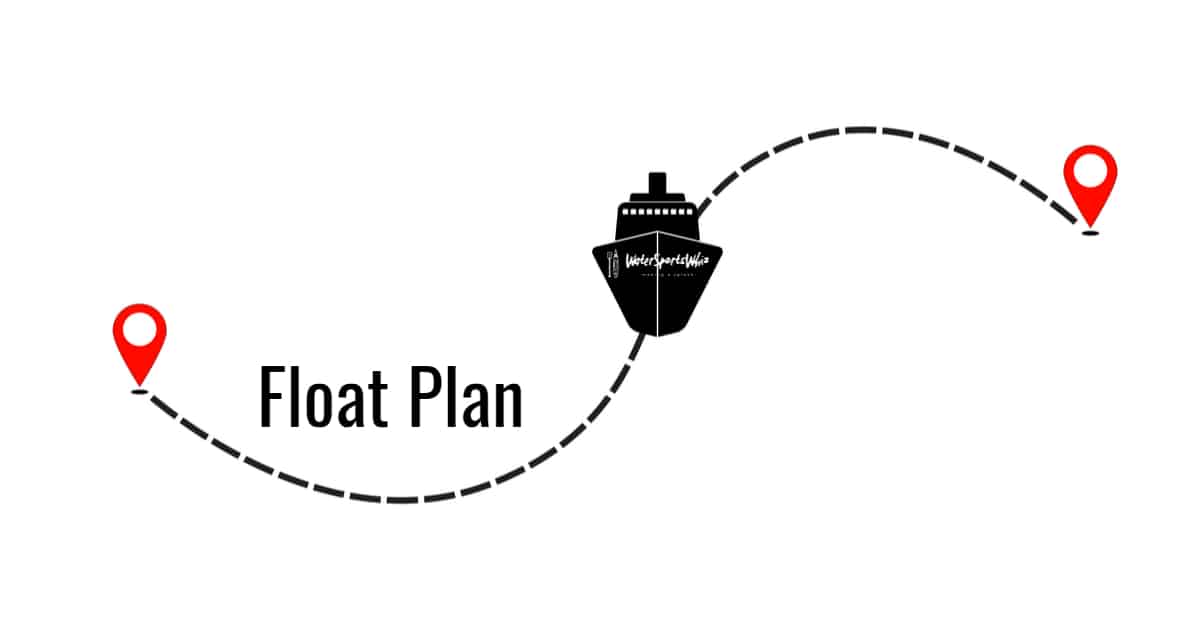A float plan is a document that accurately outlines crucial aspects of your boating trip – the Who, What, Where, and When – and serves as an on-the-water safety measure, helping others locate you if you don’t return as planned.
You’d probably let someone know where you’re headed and when you’ll be back before taking a trip, right? The same goes for boating excursions – although you have to be a lot more detailed than that and prepare an actual float plan:
Today’s not just about me convincing you that you need one, though.
It’s about showing you how to plan your route and create a float plan that describes your boating excursion as accurately as possible!
Key Takeaways
- What is a float plan? A float plan is a document that provides a detailed and accurate outline of a boat trip and can help locate the boater in an emergency situation.
- Who needs a float plan? Anyone who is planning a boating trip – be it a short outing or a multi-day excursion – should file a float plan.
- What to include on a float plan: It should contain the 4 Ws of your outing – Who, What, Where, and When.
- Filing a float plan: Do not file a float plan with the Coast Guard. Instead, share it with at least two responsible adults – a spouse, family member, or best friend.
What Is A Float Plan?

A float plan is a safety document that contains an accurate outline of your excursion, covering the WHO, WHAT, WHERE, and WHEN of your boat outing. It informs others of where you’re boating, who’s coming with you, what equipment you’re using, and when you’ll arrive at your destination – providing vital information to search and rescue personnel in case of an emergency.
Do you know that note you sometimes leave on the fridge? It usually says something like:
“Went fishing with so-and-so; will be back by dinner.“
Well, think of your float plan as the more detailed equivalent of that note.
What Is The Purpose Of Filing A Float Plan?
The purpose of filing a float plan is to act as a safety measure, much like wearing a PFD or using kayak night lights. If you don’t return as planned, the float plan will give the authorities a head start in a search and rescue mission. Otherwise, they might have to base it solely on vague conversations and basic – often unreliable – information from your family and friends, which needs to be accurately remembered and ultimately conveyed to help locate you quickly.
In short – the point of a float plan is to help others help you.
The more detailed and specific the outline, the better; reliable information and hard facts can make a difference in the outcome.
Who Should Prepare A Float Plan?
A float plan should be prepared by anyone who is planning a boating trip. Whether you are a recreational boater in a small vessel (a kayak or canoe, for example) or operating a yacht or any other type of motor-powered boat, you will need a float plan – yes, even if you plan on spending no more than a few hours on the water.
Here’s what kind of boaters prepare float plans:
- Recreational Boaters: Whether you’re going on a short trip near the shore or planning a longer outing, you need to file a float plan. It is even more important if you’ll be boating in a remote or less traveled area.
- Kayakers and Canoeists: Kayaks and canoes are relatively small vessels, susceptible to changes in weather and water conditions – which is why it’s so important for paddlers to leave a float plan with someone they trust.
- Fishermen: Both recreational and commercial fishermen should prepare a float plan, as they often venture into open waters or remote areas.
- Sailors: Anyone planning a sailing trip – regardless of the duration – should have a float plan to outline their intended route and schedule.
- Paddle Boarders: Even if they’re just going out for a few hours, paddle boarders should let someone know about their plans.
- Divers: While they’re not technically boaters, scuba divers and snorkelers – especially those diving from a private vessel – should leave a float plan to indicate their exact dive location and expected return time.
A Float Plan Should Contain What Information?

A float plan should contain an accurate description of the boating excursion and include concrete details, such as vessel information, number of people on board, proposed route and destination, and departure and return dates and times.
Float plans can vary from home-made, common-sense lists to standardized documentation – but the idea behind them remains the same:
You’re leaving a footprint of sorts for search and rescue personnel to follow in an emergency situation.
There are plenty of online resources for creating a float plan, many of which are available as PDF forms you can fill out, save, and then email or print before filing. For instance, the USCG has a free float plan available for download.
I took the liberty of creating a downloadable and print-friendly float plan template, as well. Be sure to check it out before your next outing.
If it’s easier to grasp what should be included, you can view it as the four Ws of a float plan.
#1 WHO Is Going?
Float plans usually start with a round-up of who is going. And no, “Jack, Mike, and me” doesn’t count as accurate – let alone detailed – passenger information.
So, be sure to provide the following information about the people on board:
- Boat or cruise operator’s name, age, physical description, medical information, experience, address, contact information, and, if applicable, the Maritime Mobile Service Identity (MMSI) number
- Number of people on board
- Name, age, physical description, medical conditions, address, and contact information of each person; add skill levels if you’re kayaking or canoeing in a group
Furthermore, this section should also cover the details about your vessel, including:
- Name of the vessel
- Type, year, and make of the boat
- Boat size and color
- Type of propulsion (engine, paddle, sail)
- Hull Identification Number (HIN) or Vessel Identification Number (VIN)
- Onboard boating safety equipment, including navigation equipment, distress signals, marine radio, anchor, and number and color of the PFDs
Consider providing a photo of your vessel to back up the info provided in this section, too.
#2 WHERE Are You Going?
The point of this section of your float plan is to note down where you are going – your line of travel – as accurately as possible.
Think of this as putting together a trip itinerary – the proposed outline of your route containing a list of different locations you plan on visiting on your trip.
Don’t just write down the name of the river or bay they’ll be boating in, though – that would be of little help. Instead, try to be as detailed and accurate as possible when outlining your boating route – and include:
- Your planned launch spot
- A list of take-out points for each day of the trip, as well as other put-in sites if you’ll be portaging at any point along your route
- Alternative “plan B” routes you might take depending on conditions
- Description of your vehicle – make, model, year, color, and license plate – if you’ll drive to the launch spot
You can even include a map – in paper or digital form – with your paddling route marked on it.
#3 WHEN Will You Be Back?
This section of your float plan should contain information regarding your trip itinerary – important dates and check-in times – and clearly state when you will be back.
The guardians of your float plan can’t know when it’s time to get the Coast Guard and SAR teams involved if you don’t specify when you’ll return.
So, when it comes to the third W of your float plan, you want to include:
- Planned launch date and time
- Estimated date and time of arrival
- Estimated date and time of return from your trip
- Check-in times (when you’ll call to check in and let them know everything’s going as planned)
- How long to wait until they notify the authorities about a missed check-in
#4 WHAT To Do If You Don’t Return?
This section of the float plan should provide specific instructions for the guardians on who to call and what to do if you don’t return. It serves as an escalation plan – just in case there’s a boating emergency.
If you don’t check in as scheduled, fail to close out your plan in due time, or don’t return from the trip, how long should they wait before alerting authorities?
You want that time-frame clearly stated in the float plan.
Filing your float plan with someone you trust is a crucial step – but so is agreeing on who you’ll call to close out your float plan when you reach your destination. The same goes for deciding on check-in points along the route.
Filing A Float Plan: Who To File It With & Your Responsibilities Afterwards

Pick two responsible adults to file your float plan with – be it your spouse, your best friend, family member, or your next-door neighbor; any responsible party you trust to have your back. It’s also wise to leave a copy with your departing marina. Do this before you depart and allow enough time for everyone to go over it and ask questions.
They must understand what their responsibilities are as guardians of the float plan. You’re counting on these people to contact the Coast Guard should something go wrong or you don’t return as planned, after all.
They will, in a way, act as intermediaries between you and the Coast Guard – which brings me to another common float-plan-related question:
Should I File My Float Plan With The US Coast Guard?
Going straight to the authorities in charge of search and rescue operations seems like a good idea – but:
You should, under no circumstances, try to file your float plan with the US Coast Guard; they won’t accept it.
Don’t leave your float plan guardians scrambling to find the right emergency contacts. Include these numbers in a big, bold, can’t-miss-it type of print, right there on your float plan.
What If Your Plans Change Mid-Trip?
If your plans change mid-trip, remember to notify your float plan’s guardians. Your person of trust should be up-to-date at all times.
Failing to reach out to your float plan contacts could cause lots of unnecessary worrying. They might alert the authorities and launch an expensive rescue mission when there’s no need for it.
Lastly, remember to do a final check-in and “close out” your float plan once you arrive at your destination. You know you’re alive and well – but the people waiting at home don’t.
Float Plan – A Quick Summary
To sum it up, here are the general rules for putting together and filing a detailed float plan:
- Provide a detailed description of the vessel, preferably with a photo attached, and information about the relevant safety equipment on board
- List all passengers by name, complete with physical descriptions, age, address, contact info, and experience
- Describe the intended route in detail, stops along the way, and put-in and take-out spots
- Note departure date and time and provide estimated date and time of arrival
- Leave instructions in case of an emergency
- Choose two responsible adults to be the guardians of your float plan; don’t file it with the US Coast Guard
